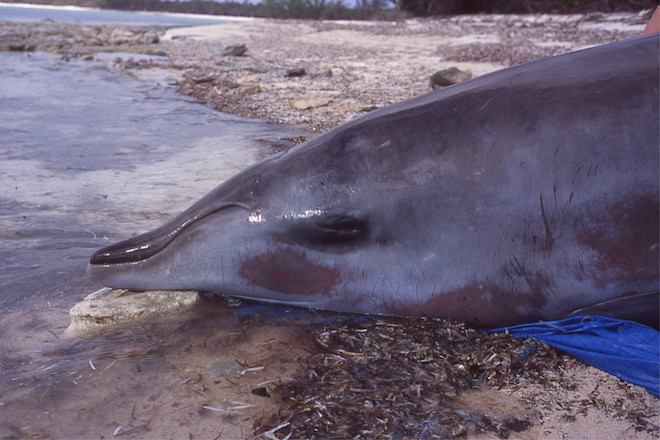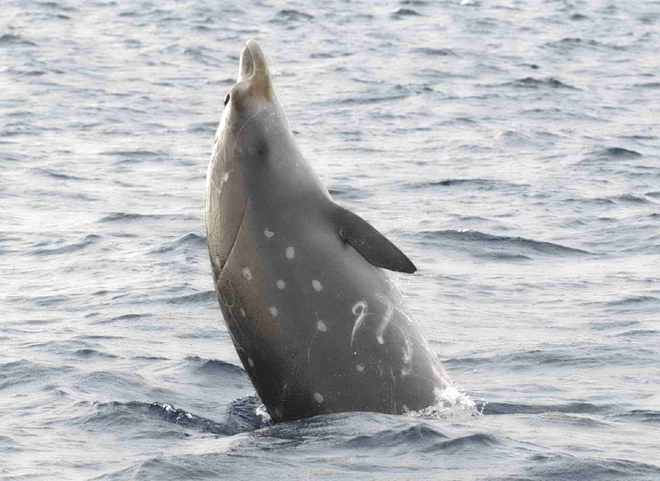It was an terrible and extraordinary event: Beaked whales are the world's deepest-diving mammals, and these creatures had spent most of their lives in deep undersea canyons. For even one to show up in shallow water would be extremely unusual.
For 17 to strand was almost inconceivable, and it might have remained a mystery but for an equally extraordinary coincidence. Just a few feet away from one of the beaches lived Ken Balcomb, a beaked whale researcher who more than anyone in the world was equipped to find out what happened.
Long before he started studying whales, Balcomb had served two tours of duty in the Navy, where he'd done classified work with submarine-detecting sonar. He knew just how loud it could be, and in days following the stranding photographed Navy destroyers in Bahamian waters. He also had the wherewithal to have several of the dead whales' heads sent for autopsies - and when they returned evidence of hemorrhages, Balcomb knew what happened. They'd fled to shallow water to escape noise so concussively loud it burst blood vessels in their brains.
"I believe the Navy did it," Balcomb soon announced at a press conference. With that began an epic legal and scientific battle to make the Navy admit what happened, and then to do something about it. Against all odds, it's a battle in which Balcomb and environmentalists have been largely successful, winning commitments from the Navy to research sonar's effects on whales and to consider them when planning training exercises.
"This story is a great example of what individuals can do," says Joshua Horwitz, author of War of the Whales, a new book that recounts this incredible tale. "You can turn around the biggest Navy in the world." WIRED talked to Horwitz about Balcomb, whales and what it takes to save their lives in ever-louder oceans.
WIRED: Tell me about the importance of sonar to beaked whales. They're an unfamiliar species for many people.
Joshua Horwitz: These beaked whales in the Bahamas are the deepest-diving mammals in the world. They go down two miles deep, where the squid are. They've evolved to find hard-shelled animals in the dark. And like all toothed whales - which is half of all cetaceans, from dolphins up to sperm whales - they've developed a very sensitive sonar of their own. They are acutely acoustic animals.
WIRED: What's it like for a beaked whale, so exquisitely sensitive to sound, to experience high-powered military sonar?
Horwitz: Imagine these animals who spend their days and nights diving slowly down to a depth of a mile or more, hunting for an hour, then slowly rising. They're in an enclosed, deepwater canyon. That's their daily routine.
Now imagine Navy frigates sweeping above the canyons between midnight and dawn and filling them with sound. What the Navy's acoustic modeling later showed is that the sound collects in layers. This entire canyon is like a bathtub and fills with sound. The sound never escapes.
We don't know exactly what it feels like for a whale, but we know how sensitive they are to sound. If you listen to recordings of the sonar, it's incredibly unpleasant and distressing. Later the Navy did tagging studies to watch how whales operate in response to sound. It's clear they want to get away - but there was no exit for these whales. It was an acoustic storm.
WIRED: So what do you do if you're Ken Balcomb - one man, facing one of the most powerful institutions in the world?
Horwitz: He was a loyal Navy veteran. He'd never talked about the classified work he did. He was really torn. He did his best to get the Navy to investigate this. And when it got to a point where he felt the Navy was going to bury the investigation and the story, he made the decision, after much soul-searching, to become a reluctant activist.
He had cut off the heads of the dead beaked whales, and delivered them by plane to a lab where a Navy-funded research team did CT scans. They found pretty definitive evidence of acoustic trauma in their brains. But once he handed over the heads, he wasn't invited to the necropsy. He was shut out of the evidence trail.
So he made the decision to go public. He went to a press conference held by the Natural Resources Defense Council and other groups at the National Press Club. He brought photographs and videotapes. It was broadcast on 60 Minutes, and that forced the Navy's hand.
Balcomb's role was to force the Navy to do an investigation of this. Otherwise it never would have happened.

Horwitz: Reynolds is a layperson, not a scientist, but he was on to the connection between Navy sonar and whale deaths before the scientific community was. There had been isolated observations by scientists in the field about the seeming confluence of these events. Reynolds tried to connect the dots and build interest within the scientific community. He spent the late 1990s traveling to whale science conferences, saying, "Guys, you should be looking at this!" And the researchers said, "You're not a scientist. If there was a connection, we'd see it."
What was missing was the evidence trail. When these animals strand in the tropics, in remote locations, if you don't get to them immediately and take their heads like Balcomb did, they rot on the beach. Balcomb was right there. It happened in his backyard. As soon as Reynolds heard, he was all over it.
The NRDC is a fairly powerful law firm, but Reynolds was a lone wolf there. They'd never done marine mammal cases before. His colleagues rolled their eyes: "Are you really going after the Navy on this?" But Reynolds grabbed hold and wouldn't let go. And he's still at it.
That's a takeaway for this story. It's a portrait of how two individuals can make a change. If they hadn't been there, nobody would know. There are always going to be people who put their interest ahead of wildlife. But if you have the right kind of commitment, you can move mountains.
WIRED: But should the whales' interests come before national security? There are probably lots of people who care about whales but don't want to jeopardize America's safety for them.
Horwitz: This has always been about training exercises, not about warfare. Nobody's saying that if you have an aircraft carrier in the Gulf, you shouldn't use sonar to protect it from enemy subarmines. But whales shouldn't have to die for practice.
WIRED: The best-known of Reynolds' legal cases is probably a 2008 decision in which the Supreme Court court ruled in the Navy's favor, saying that national security outweighed the whales' legal protections. Doesn't that mean the legal fight was lost?
Horwitz: That was the only case the Navy won. It followed on major losses in California and Hawaii, where they'd settled.
In the 2008 case, they went to the White House and asked for an executive waiver from laws protecting the whales, which the Bush administration gave to them. A federal appeals court threw that out. So the Navy went to the Supreme Court, and the Supreme Court agreed with them - but the decision was what's known as a "soft landing."
A hard landing is where the Supreme Court rewrites laws, and says the old ones were broad and unconstitutional. The court didn't say that. They said the Navy was bound by those laws, but that the lower court hadn't given them something called due deference. It was a bad decision for environmentalists, but it hasn't hobbled their ability to take their fight to court.
WIRED: This isn't just a Navy problem, though.
Horwitz: The bigger issues in noise pollution are oil and gas exploration, and also international shipping.
In 2008 there was a stranding of 100 melon-headed whales off the coast of Madagascar. It was traced to an ExxonMobil sonar survey ship.
And all the ships going back and forth around the world create a chronic amount of noise pollution that threatens lots of marine life, not just whales.
The problem with going after international shipping is that it's international. It's a lot tougher. The NRDC has confronted and reached settlements with oil and gas companies, but the companies have endlessly deep pockets and political muscle.
Success is about raising awareness and getting cooperation among the parties. There's some of that already. The Europeans are far ahead of us in regulating noise pollution in coastal waters. Ironically, the Navy is best-suited to address this. They're expert in noise-quieting technologies for ships. If they shared that technology with the commercial sector, ocean noise could be cut significantly.
WIRED: Can sonar be made quieter?
Horwitz: The simplest solution is for the Navy not to train in whale habitats when whales are there. That's what environmentalists are pushing for: geographic and seasonal exclusions. If you need to train, find somewhere the whales are not. It's a big ocean.
In April, beaked whales stranded off the coast of Crete, where the Greek, U.S. and Israeli navies were running training exercises. Again, it was for training, not actual warfare situations.
But the Navy has not been back to the Bahamas since the strandings there. That's what the process is all about. There are technological and common-sense solutions, but you have to be committed institutionally to them.
WIRED: Would that work for types of low-frequency sonar that can travel across entire ocean basins?
Horwitz: That's why the NRDC has been in court for so long. It's harder to control. And that's why, up until now, the NRDC has been able to restrict its use to a few areas where the Navy insists it's important. Again, it comes down to some degree of national security versus environmental concerns.
WIRED: Do you think there's hope for the future?
Horwitz: What the Navy has responded to in the past has been public action, an aroused press and legal action on behalf of citizens. And if you look at the big picture, it's very different compared to 20 years ago, when the Navy wasn't even applying for permits. Now they're playing by the rules. Bending the rules around the edges, yes - but after spending seven years writing this book, my conclusion is that it's a success story.
If you look at how the Navy operates now, it's a night-and-day difference. But that doesn't mean it can't be a brighter day. And this story is a great example of what individuals can do. With media support and public action, you can do anything. You can turn around the biggest Navy in the world.




Reader Comments